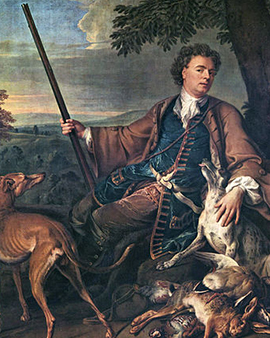Alexandre-François Desportes, a master of the French Baroque whose brushstrokes captured the essential vitality of nature, was born on February 24, 1661 in Champigneulle, Ardennes, and died on April 20, 1743. Known for his precise and vivid depictions of animals, Desportes paved the way for animal painting and established an art form that is still considered inspirational today. Our carefully curated art prints are a tribute to his unique art, allowing you to experience the intricacy and detail of his work reflected in each art print in our collection.
Desportes learned the art of painting in Paris, in the studio of the Flemish painter Nicasius Bernaerts, a student of Frans Snyders or Snijders. A brief stay in Poland, during which he painted portraits of John III Sobieski and Polish aristocrats, brought a turn in his career. After the king's death, Desportes returned to Paris and from then on specialized in painting animals and flowers. The Academy of Painting and Sculpture accepted him in 1699. A self-portrait in hunting costume, now in the Louvre, is a testament to his masterful artistry. Desportes' career was marked by royal commissions, including numerous decorative panels for the royal palaces of Versailles, Marly, Meudon, Compiègne, and most recently for Louis XV at Choisy in 1742. Both Louis XIV and Louis XV commissioned him to create portraits of their beloved hunting dogs. Using a small notebook to make quick sketches, Desportes followed the royal hunt and then created detailed and colorful paintings.
In addition to his devoted work on animal portraits and studies, Desportes also participated in the production of cartoons for tapestries and designed the famous tapestry series "Les Nouvelles Indes". At his death, he left behind a studio full of works and studies, a legacy that runs throughout the 18th century and is still present in the iconography of French art today. Desportes' eye for detail and his striking depictions of animals are unmatched in the art world. He often combined still lifes of game with magnificent silver pieces that might have been displayed in dining rooms. These works are valuable documents of the vanished silver of Louis XIV's time, and our art prints of these works allow you to admire and appreciate the elegance and detail of his art.
Most of Desportes' work remained in his studio, including numerous studies of animals and plants, some of them sketches modeled on Jan Fyt's Fox Hunt. In 1784, the Comte d'Angiviller, general director of the Bâtiments du Roi, acquired these works for painter's models at the Sèvres Porcelain Manufactory. Desportes' influence thus extended throughout the 18th century, leaving an indelible stamp on French art history. By reproducing Desportes' works as art prints, we honor his art and keep his legacy alive. Each art print is a masterpiece in its own right, carefully reproduced to reflect the original beauty and precision of his works. Whether you are a lover of classical art or simply want to preserve a piece of history, our art prints pay homage to the mastery and legacy of Alexandre-François Desportes.
×





.jpg)
.jpg)
_by_Alexandre-Francois_De_-_(MeisterDrucke-1080033).jpg)
_by_Alexandre-Francois_De_-_(MeisterDrucke-1080033).jpg)
.jpg)
.jpg)
_-_(MeisterDrucke-1004484).jpg)
_-_(MeisterDrucke-1004484).jpg)
_18th_century_Par_-_(MeisterDrucke-1023656).jpg)
_18th_century_Par_-_(MeisterDrucke-1023656).jpg)
_Painting_by_Francois_Des_-_(MeisterDrucke-1023417).jpg)
_Painting_by_Francois_Des_-_(MeisterDrucke-1023417).jpg)
.jpg)
.jpg)
.jpg)
.jpg)
_18th_centu_-_(MeisterDrucke-1029929).jpg)
_18th_centu_-_(MeisterDrucke-1029929).jpg)
_18th_century_-_(MeisterDrucke-1023655).jpg)
_18th_century_-_(MeisterDrucke-1023655).jpg)
_Painting_by_Francois_Despo_-_(MeisterDrucke-1023416).jpg)
_Painting_by_Francois_Despo_-_(MeisterDrucke-1023416).jpg)
.jpg)
.jpg)
.jpg)
.jpg)
.jpg)
.jpg)
.jpg)
.jpg)
.jpg)
.jpg)
_18th_centur_-_(MeisterDrucke-947357).jpg)
_18th_centur_-_(MeisterDrucke-947357).jpg)
_1725_Sun_336x332_m_reindeer_-_(MeisterDrucke-996450).jpg)
_1725_Sun_336x332_m_reindeer_-_(MeisterDrucke-996450).jpg)
_F_-_(MeisterDrucke-1091074).jpg)
_F_-_(MeisterDrucke-1091074).jpg)
.jpg)
.jpg)
.jpg)
.jpg)
_Detail_Painting_by_Francoi_-_(MeisterDrucke-984321).jpg)
_Detail_Painting_by_Francoi_-_(MeisterDrucke-984321).jpg)
.jpg)
.jpg)
_1718_Sun_11x_-_(MeisterDrucke-985356).jpg)
_1718_Sun_11x_-_(MeisterDrucke-985356).jpg)
 - (MeisterDrucke-73033).jpg)
 - (MeisterDrucke-73033).jpg)
.jpg)
.jpg)
.jpg)
.jpg)
.jpg)
.jpg)
_Painting_by_Francois_Despor_-_(MeisterDrucke-1023415).jpg)
_Painting_by_Francois_Despor_-_(MeisterDrucke-1023415).jpg)
.jpg)
.jpg)
 (one of a pair see also 40086) - (MeisterDrucke-79123).jpg)
 (one of a pair see also 40086) - (MeisterDrucke-79123).jpg)
.jpg)
.jpg)
.jpg)
.jpg)
.jpg)
.jpg)
.jpg)
.jpg)
.jpg)
.jpg)
.jpg)
.jpg)
.jpg)
.jpg)
.jpg)
.jpg)
.jpg)
.jpg)
.jpg)
.jpg)
_France_-_(MeisterDrucke-1091083).jpg)
_France_-_(MeisterDrucke-1091083).jpg)
.jpg)
.jpg)
_France_-_(MeisterDrucke-1092204).jpg)
_France_-_(MeisterDrucke-1092204).jpg)
.jpg)
.jpg)
.jpg)
.jpg)
.jpg)
.jpg)
_-_(MeisterDrucke-1493842).jpg)
_-_(MeisterDrucke-1493842).jpg)
_France_-_(MeisterDrucke-1081305).jpg)
_France_-_(MeisterDrucke-1081305).jpg)
.jpg)
.jpg)
.jpg)
.jpg)
_F_-_(MeisterDrucke-1092200).jpg)
_F_-_(MeisterDrucke-1092200).jpg)
.jpg)
.jpg)
.jpg)
.jpg)
.jpg)
.jpg)
.jpg)
.jpg)
_-_(MeisterDrucke-1003030).jpg)
_-_(MeisterDrucke-1003030).jpg)
.jpg)
.jpg)
.jpg)
.jpg)
_France_-_(MeisterDrucke-1081403).jpg)
_France_-_(MeisterDrucke-1081403).jpg)
_France_-_(MeisterDrucke-1092199).jpg)
_France_-_(MeisterDrucke-1092199).jpg)
 (one of a pair see also 40087) - (MeisterDrucke-97118).jpg)
 (one of a pair see also 40087) - (MeisterDrucke-97118).jpg)
.jpg)
.jpg)
_Painting_by_Fr_-_(MeisterDrucke-946958).jpg)
_Painting_by_Fr_-_(MeisterDrucke-946958).jpg)
.jpg)
.jpg)
.jpg)
.jpg)
.jpg)
.jpg)
.jpg)
.jpg)
_-_(MeisterDrucke-1002919).jpg)
_-_(MeisterDrucke-1002919).jpg)
_18th_century_Sun_372_-_(MeisterDrucke-951825).jpg)
_18th_century_Sun_372_-_(MeisterDrucke-951825).jpg)
.jpg)
.jpg)
.jpg)
.jpg)
.jpg)
.jpg)
.jpg)
.jpg)
.jpg)
.jpg)
.jpg)
.jpg)
_-_(MeisterDrucke-969891).jpg)
_-_(MeisterDrucke-969891).jpg)
.jpg)
.jpg)
 - (MeisterDrucke-230124).jpg)
 - (MeisterDrucke-230124).jpg)
.jpg)
.jpg)
.jpg)
.jpg)
.jpg)
.jpg)






